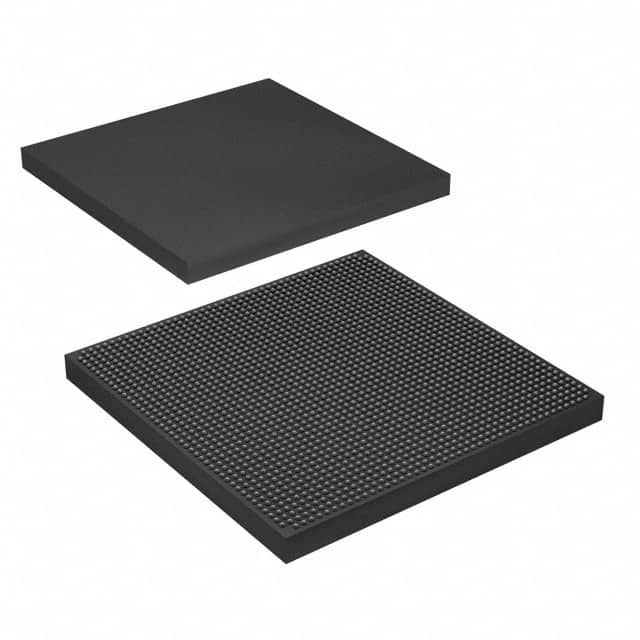Xem thông số kỹ thuật để biết chi tiết sản phẩm.

EP4SGX290NF45C2N
Product Overview
- Category: Field Programmable Gate Array (FPGA)
- Use: Digital logic circuits and systems
- Characteristics: High-performance, reconfigurable, programmable
- Package: 45nm Flip-Chip BGA package
- Essence: Versatile integrated circuit for implementing complex digital designs
- Packaging/Quantity: Available in trays or tape and reel packaging
Specifications
- Manufacturer: Intel Corporation
- Family: Stratix IV GX
- Device: EP4SGX290NF45C2N
- Technology: 45nm
- Logic Elements: 290,000
- Embedded Multipliers: 1,288
- Memory Bits: 8,062,720
- I/O Pins: 622
- Operating Voltage: 1.0V
- Speed Grade: -2
- Temperature Range: -40°C to +100°C
Detailed Pin Configuration
The EP4SGX290NF45C2N FPGA has a complex pin configuration with various pins serving different functions. For a detailed pin configuration diagram, please refer to the manufacturer's datasheet.
Functional Features
- High-performance FPGA suitable for demanding applications
- Reconfigurable architecture allows for flexibility in design implementation
- Supports a wide range of digital logic functions and algorithms
- Integrated memory blocks for efficient data storage and retrieval
- Built-in high-speed transceivers for fast data communication
- On-chip PLLs for clock generation and synchronization
- Support for various communication protocols and interfaces
Advantages and Disadvantages
Advantages: - High-performance and versatility for complex digital designs - Reconfigurable nature allows for design modifications without hardware changes - Large number of logic elements and embedded multipliers for computational tasks - Extensive I/O capabilities for interfacing with external devices - Support for various communication protocols and interfaces
Disadvantages: - Higher power consumption compared to simpler logic devices - Steeper learning curve for beginners due to complexity - Higher cost compared to simpler programmable logic devices
Working Principles
The EP4SGX290NF45C2N FPGA operates based on the principles of digital logic circuits. It consists of a large number of configurable logic elements interconnected through programmable routing resources. These logic elements can be programmed to implement desired digital functions and algorithms.
The FPGA's configuration is stored in internal memory cells, which can be reprogrammed to modify the design without changing the hardware. The device is controlled by a clock signal, and its functionality is determined by the interconnections between logic elements and their programming.
Detailed Application Field Plans
The EP4SGX290NF45C2N FPGA finds applications in various fields, including:
- Telecommunications: Used in base stations, routers, and network switches for high-speed data processing and communication.
- Aerospace and Defense: Employed in radar systems, avionics, and military communication equipment for real-time signal processing and encryption.
- Industrial Automation: Utilized in control systems, robotics, and machine vision applications for precise control and data processing.
- High-Performance Computing: Integrated into supercomputers and data centers for parallel processing and acceleration of complex algorithms.
- Medical Imaging: Applied in medical imaging devices such as MRI and CT scanners for image reconstruction and processing.
Detailed and Complete Alternative Models
- EP4SGX230KF40C2N: Similar FPGA from the same family with a lower logic element count.
- EP4SGX530KH40C2N: Higher-end FPGA from the same family with increased logic elements and I/O pins.
- EP4SGX70HF35C2N: Lower-cost FPGA from the same family with reduced logic elements and I/O pins.
These alternative models offer different performance levels and price points to cater to various design requirements.
Word count: 446 words
Liệt kê 10 câu hỏi và câu trả lời thường gặp liên quan đến ứng dụng EP4SGX290NF45C2N trong giải pháp kỹ thuật
Sure! Here are 10 common questions and answers related to the application of EP4SGX290NF45C2N in technical solutions:
Q: What is EP4SGX290NF45C2N? A: EP4SGX290NF45C2N is a specific model of Field-Programmable Gate Array (FPGA) manufactured by Intel.
Q: What are the key features of EP4SGX290NF45C2N? A: Some key features of EP4SGX290NF45C2N include high-speed performance, low power consumption, large capacity, and support for various interfaces.
Q: In what technical solutions can EP4SGX290NF45C2N be used? A: EP4SGX290NF45C2N can be used in a wide range of applications such as telecommunications, data centers, industrial automation, aerospace, and defense.
Q: How does EP4SGX290NF45C2N contribute to telecommunications solutions? A: EP4SGX290NF45C2N can be used in telecommunications solutions to enable high-speed data processing, protocol conversion, signal modulation/demodulation, and network optimization.
Q: Can EP4SGX290NF45C2N be used in data center applications? A: Yes, EP4SGX290NF45C2N can be utilized in data centers for tasks like accelerating data encryption/decryption, improving network performance, and implementing custom algorithms.
Q: What advantages does EP4SGX290NF45C2N offer in industrial automation? A: EP4SGX290NF45C2N provides real-time control capabilities, high-speed data processing, and flexibility to adapt to changing requirements in industrial automation applications.
Q: How does EP4SGX290NF45C2N support aerospace solutions? A: EP4SGX290NF45C2N can be used in aerospace applications for tasks like radar signal processing, image/video processing, flight control systems, and communication interfaces.
Q: Can EP4SGX290NF45C2N be used in defense-related projects? A: Yes, EP4SGX290NF45C2N is suitable for defense applications such as secure communications, radar systems, electronic warfare, and missile guidance systems.
Q: Does EP4SGX290NF45C2N support different interface standards? A: Yes, EP4SGX290NF45C2N supports various interface standards like PCIe, Ethernet, USB, HDMI, SATA, and DDR3/DDR4 memory interfaces.
Q: Are there any development tools available for working with EP4SGX290NF45C2N? A: Yes, Intel provides Quartus Prime software suite, which includes design tools, simulation tools, and programming tools specifically designed for FPGA development, including EP4SGX290NF45C2N.
Please note that the specific applications and features mentioned above are just examples, and the actual usage of EP4SGX290NF45C2N may vary depending on the project requirements.

